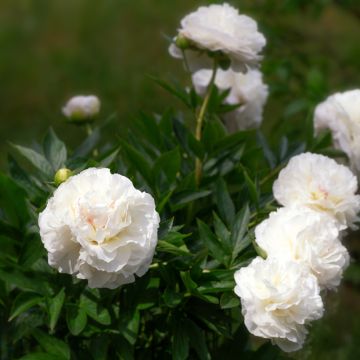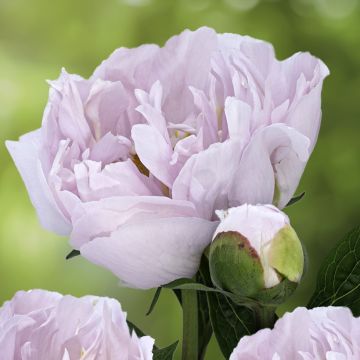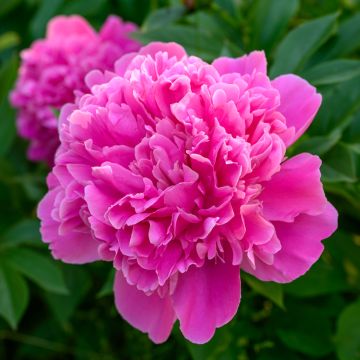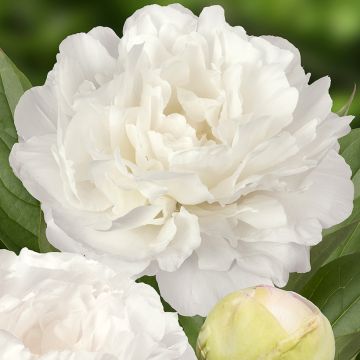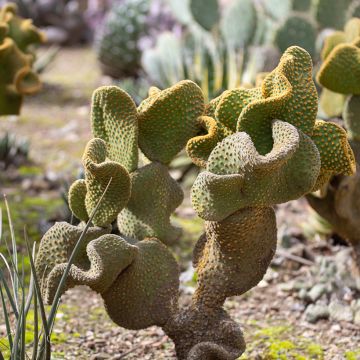

Paeonia lactiflora peregrina Flame


Paeonia lactiflora peregrina Flame


Paeonia lactiflora peregrina Flame
Paeonia lactiflora peregrina Flame
Paeonia lactiflora x peregrina Flame
Hybrid herbaceous Peony
Well-packaged young plants. Foliage slightly damaged but nothing serious. What bothers me is that during the repotting, all the soil fell off as if they had just been repotted before shipping. I hope this won't compromise their recovery, it would be a shame!
Martine H., 07/06/2018
Special offer!
Receive a €20 voucher for any order over €90 (excluding delivery costs, credit notes, and plastic-free options)!
1- Add your favorite plants to your cart.
2- Once you have reached €90, confirm your order (you can even choose the delivery date!).
3- As soon as your order is shipped, you will receive an email containing your voucher code, valid for 3 months (90 days).
Your voucher is unique and can only be used once, for any order with a minimum value of €20, excluding delivery costs.
Can be combined with other current offers, non-divisible and non-refundable.
Home or relay delivery (depending on size and destination)
Schedule delivery date,
and select date in basket
This plant carries a 12 months recovery warranty
More information
We guarantee the quality of our plants for a full growing cycle, and will replace at our expense any plant that fails to recover under normal climatic and planting conditions.
Would this plant suit my garden?
Set up your Plantfit profile →
Description
The Paeonia Flame is a hybrid of Paeonia peregrina and P. lactiflora, one of the most sumptuous botanical peonies in central Europe. This variety, quite rare in cultivation, offers an unprecedented red flowering, with coral accents, turning to almost fluorescent magenta pink, a truly incandescent flowering. It chooses the middle of spring to open its globe-shaped corollas, visible from afar, adorned with prominent golden stamens. Rather early flowering, enhanced by abundant foliage, dark green and beautifully cut, gathered in a compact clump. This perennial plant is cultivated in ordinary, well-drained soil, rather moist, in full sun or partial shade.
The Flame Peony, obtained in 1939 by Glasscock, comes from Paeonia lactiflora, a famous botanical species native to central and eastern Asia, and from P. peregrina 'Sunbeam'. This plant belongs to the Ranunculaceae or Paeoniaceae family. It is a hardy plant, with rather slow growth during the first years, eventually forming a bushy and dense clump averaging 70 cm (28in) in all directions. Its stems bear leaves divided into leaflets 5 to 12 cm (2 to 5in) long, shiny green on the upper side, duller and bluish on the underside. The flowers, in simple cup shape, globular, appear at the beginning or middle of May, at the end of very firm stems. They measure 7 to 10 cm (3 to 4in) in diameter and are composed of petals that shine like rayon, intense orange-red evolving towards magenta pink, surrounding a large heart of yellow stamens. In sandy soil, the coral colour of the flowers will be more pronounced. This flowering is followed by the formation of black, round and smooth seeds, which germinate after exposure to cold.
Peonies are among those plants that form the foundation of a garden. In the past every garden, from the humblest to the most elaborate, proudly displayed clumps of peonies that made their way into the house, keeping lilacs and bluebells company in bouquets. Incandescent and vigorous, the robust Flame peony will settle into well-drained borders, cool rockeries or alongside pathways, in combination with timeless perennials such as columbines, bellflowers, foxgloves, bearded irises, carnations, or Christmas roses. It can also be grown in the vegetable garden to supply cut flowers for the house. Growing it in a pot is not recommended, as its needs will not be met. Over time, the peony becomes majestic and blooms more and more abundantly.
Report an error about the product description
Paeonia lactiflora peregrina Flame in pictures




Flowering
Foliage
Plant habit
Botanical data
Paeonia
lactiflora x peregrina
Flame
Ranunculaceae
Hybrid herbaceous Peony
Cultivar or hybrid
Other Herbaceous and hybrid Peonies
View all →Planting and care
The Flame peony, like all peonies, does not like to be moved so you have to think carefully about the right place to locate it. The best time to plant is in spring or autumn. Give the stumps a sunny or bright location and deep, well-loosened soil, making sure it is properly drained. Peonies need space and dislike competition from other species. Prepare a hole of 50 x 50 x 50 cm (20in), adding a thin layer of sand or gravel at the bottom to provide drainage around the roots. Mix an organic fertiliser into your soil, partially backfill, place your plants inside and cover with 6 cm (2in) of soil above the eyes. After planting, tamp down and water thoroughly.
Planting period
Intended location
Care
-
, onOrder confirmed
Reply from on Promesse de fleurs
Similar products
Haven't found what you were looking for?
Hardiness is the lowest winter temperature a plant can endure without suffering serious damage or even dying. However, hardiness is affected by location (a sheltered area, such as a patio), protection (winter cover) and soil type (hardiness is improved by well-drained soil).

Photo Sharing Terms & Conditions
In order to encourage gardeners to interact and share their experiences, Promesse de fleurs offers various media enabling content to be uploaded onto its Site - in particular via the ‘Photo sharing’ module.
The User agrees to refrain from:
- Posting any content that is illegal, prejudicial, insulting, racist, inciteful to hatred, revisionist, contrary to public decency, that infringes on privacy or on the privacy rights of third parties, in particular the publicity rights of persons and goods, intellectual property rights, or the right to privacy.
- Submitting content on behalf of a third party;
- Impersonate the identity of a third party and/or publish any personal information about a third party;
In general, the User undertakes to refrain from any unethical behaviour.
All Content (in particular text, comments, files, images, photos, videos, creative works, etc.), which may be subject to property or intellectual property rights, image or other private rights, shall remain the property of the User, subject to the limited rights granted by the terms of the licence granted by Promesse de fleurs as stated below. Users are at liberty to publish or not to publish such Content on the Site, notably via the ‘Photo Sharing’ facility, and accept that this Content shall be made public and freely accessible, notably on the Internet.
Users further acknowledge, undertake to have ,and guarantee that they hold all necessary rights and permissions to publish such material on the Site, in particular with regard to the legislation in force pertaining to any privacy, property, intellectual property, image, or contractual rights, or rights of any other nature. By publishing such Content on the Site, Users acknowledge accepting full liability as publishers of the Content within the meaning of the law, and grant Promesse de fleurs, free of charge, an inclusive, worldwide licence for the said Content for the entire duration of its publication, including all reproduction, representation, up/downloading, displaying, performing, transmission, and storage rights.
Users also grant permission for their name to be linked to the Content and accept that this link may not always be made available.
By engaging in posting material, Users consent to their Content becoming automatically accessible on the Internet, in particular on other sites and/or blogs and/or web pages of the Promesse de fleurs site, including in particular social pages and the Promesse de fleurs catalogue.
Users may secure the removal of entrusted content free of charge by issuing a simple request via our contact form.
The flowering period indicated on our website applies to countries and regions located in USDA zone 8 (France, the United Kingdom, Ireland, the Netherlands, etc.)
It will vary according to where you live:
- In zones 9 to 10 (Italy, Spain, Greece, etc.), flowering will occur about 2 to 4 weeks earlier.
- In zones 6 to 7 (Germany, Poland, Slovenia, and lower mountainous regions), flowering will be delayed by 2 to 3 weeks.
- In zone 5 (Central Europe, Scandinavia), blooming will be delayed by 3 to 5 weeks.
In temperate climates, pruning of spring-flowering shrubs (forsythia, spireas, etc.) should be done just after flowering.
Pruning of summer-flowering shrubs (Indian Lilac, Perovskia, etc.) can be done in winter or spring.
In cold regions as well as with frost-sensitive plants, avoid pruning too early when severe frosts may still occur.
The planting period indicated on our website applies to countries and regions located in USDA zone 8 (France, United Kingdom, Ireland, Netherlands).
It will vary according to where you live:
- In Mediterranean zones (Marseille, Madrid, Milan, etc.), autumn and winter are the best planting periods.
- In continental zones (Strasbourg, Munich, Vienna, etc.), delay planting by 2 to 3 weeks in spring and bring it forward by 2 to 4 weeks in autumn.
- In mountainous regions (the Alps, Pyrenees, Carpathians, etc.), it is best to plant in late spring (May-June) or late summer (August-September).
The harvesting period indicated on our website applies to countries and regions in USDA zone 8 (France, England, Ireland, the Netherlands).
In colder areas (Scandinavia, Poland, Austria...) fruit and vegetable harvests are likely to be delayed by 3-4 weeks.
In warmer areas (Italy, Spain, Greece, etc.), harvesting will probably take place earlier, depending on weather conditions.
The sowing periods indicated on our website apply to countries and regions within USDA Zone 8 (France, UK, Ireland, Netherlands).
In colder areas (Scandinavia, Poland, Austria...), delay any outdoor sowing by 3-4 weeks, or sow under glass.
In warmer climes (Italy, Spain, Greece, etc.), bring outdoor sowing forward by a few weeks.






























